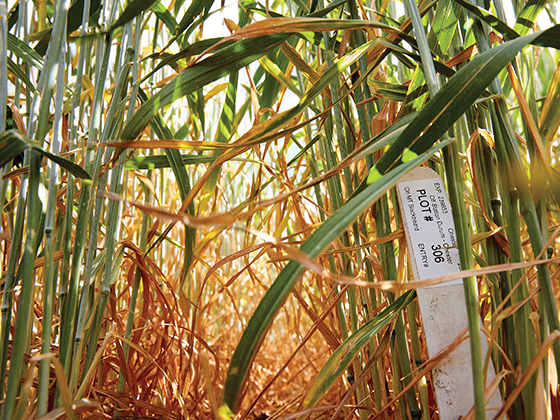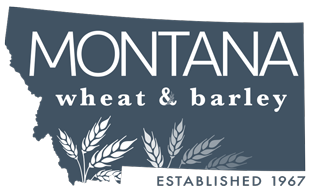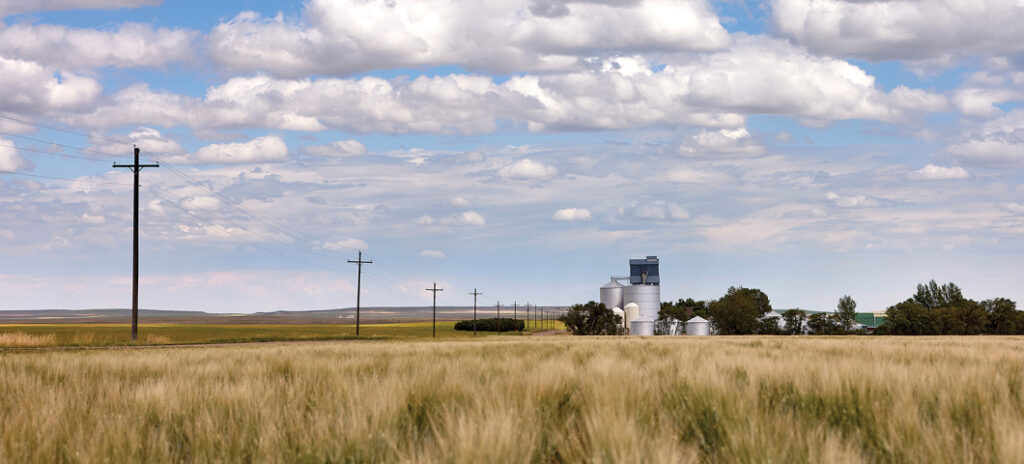Producers from across the state collaborate with MSU scientists to screen new grain varieties
by Reagan Cotton • photography by Marcus “Doc” Cravens OCTOBER 24, 2023
Seven miles west of Chester in northern Montana, acres upon acres of grain bend hypnotically in the warm summer wind. The agricultural landscape feels timeless, unchanged from when it was first homesteaded in the early 20th century by Kurt Kammerzell’s grandfather Mike.
Mike Kammerzell’s initial homestead is now the modern-day Kammerzell farm. Kurt and his family — including his wife, Kari, and their twin daughters, Khloe and Katey — are the third and fourth generations to farm the land, primarily growing wheat (including spring and winter wheat and durum), mustard and pulse crops, such as chickpeas, lentils and peas.
The Kammerzell farm belies its century of age, with shining grain elevators and precision farming vehicles. But its history is everywhere. The first building on the property, the shop and living quarters Mike Kammerzell built, stands at the center next to the pale yellow 1972 Chevrolet pickup in which Kurt picked Kari up for their first date. A 1957 gas pump — operational until 2022, Kurt says — stands next to a behemoth diesel tank for filling tractors. The gasoline price reads 35 ½ cents per gallon.
The farm’s history is intertwined with the state of Montana and Kammerzell’s own alma mater. Surrounding the farm are thousands of acres of crops developed by Montana State University scientists over decades, based on the needs and feedback of producers like the Kammerzells: all four generations of them.
For more than three decades, the family has collaborated with scientists from MSU to develop new grain varieties, and for the last decade part of that collaboration has taken place on this very land, testing those varieties bred particularly to meet the needs of producers like Kammerzell.

A newly cultivated field on the Kammerzell Farm.

A test row of Blackbeard, an MSU-developed variety of durum, which is used to make pasta.

Kurt Kammerzell surveys test plots on his farm ahead of their harvest.
An hour to the east lies MSU’s Northern Agricultural Research Center, where research scientist Peggy Lamb heads the variety testing program. The Havre center is one of seven MSU facilities across the state that conduct regionally specific research tailored to Montana’s varied climate and topography. Partnerships with producers like the Kammerzells are beneficial for both scientists and farmers, says Lamb.
“Producer relationships are important for numerous reasons,” said Lamb. “They are crucial when seeking on-farm collaborative sites for new or specific research or for support letters for grant applications. Growers provide testimony in front of the Legislature and even a skilled hand when research equipment needs to be repaired in the field. Without the producer connections and friendships built over the years, Montana State University, the College of Agriculture, Montana Agricultural Experiment Station and the Department of Research Centers would not be as productive as we are today.”
The Kammerzell farm hosts one of dozens of trials around the state where producers and MSU scientists collaborate. The Cederberg farm near Turner has hosted variety trials for nearly 40 years, while the Lumsden farm near Loring and the McKeever farm near Loma are nearing three decades — and that’s only in the state’s northern region. Those families and countless others have been instrumental in allowing MSU to become a regional leader in agricultural development, Lamb said.
Kurt Kammerzell first began fostering relationships with MSU faculty during his time as an MSU student in the 1990s. After earning an undergraduate degree in plant science, he continued to a master’s degree in entomology, studying with professor emeritus Greg Johnson. His daughter Katey will graduate from MSU as part of the class of 2024.
“When I got to college and had these professors, it changed everything. They’re all monumental people in this state. I went from an average student to straight As, because they sparked my interest and I couldn’t get enough. And those relationships are continuing today,” said Kammerzell. “As a land-grant institution, MSU is here for the state and the farmer, which is really nice. They’re very, very receptive to what producers need.”
Two of the most-planted varieties on the Kammerzell farm are Bobcat winter wheat and Dagmar spring wheat, developed by longtime breeders Phil Bruckner and Luther Talbert, both now retired. The pair spent more than 50 combined years developing MSU varieties that Kammerzell says hold up to the harsh weather of northern Montana and demonstrate resistance to the primary pest in the area, wheat stem sawfly. And while those qualities mean the varieties will likely bring in more money to producers, when Kammerzell talks about it, he speaks less in terms of dollars than in the potential for his crops to feed his fellow Montanans.
“We have 4,000 acres of wheat. If we grow a 40-bushel yield, we’ll grow about 6 million loaves of bread,” he said. “But if we grow a 50-bushel yield … that’s huge when it comes to food production, and that’s just on this farm.”
While Kammerzell has grown several MSU wheat varieties over the years, one growing season he opted for a non-MSU variety, while one of his cousins planted MSU’s Bobcat winter wheat on his own farm. Watching the Bobcat outperform the wheat he planted, Kammerzell estimates his choice meant a difference in yield worth about 850,000 loaves. This year, there are 2,500 acres of Bobcat on the Kammerzell farm and 1,500 acres of Dagmar.
Scientists at MSU are using a plot of around 150 by 200 feet on Kammerzell’s farm to test varieties of spring wheat and durum, which is used to make pasta. All the work is done by Lamb and her team, including planting varieties and returning throughout the growing season to evaluate their progress and collect data. Lamb returns to harvest the trials in late summer, and in the meantime Kammerzell sprays it with a standard pesticide, treating it just like the rest of his farm. Before harvest, MSU scientists also lead plot tours at the trial locations so that farmers and community members can learn about how different varieties are performing in the area.
The plot trials are an important final hurdle for newly developed varieties, said Lamb, because they provide an important opportunity to assess how they hold up against more established lines developed both by MSU and by industry breeders.
“Farmers get to see firsthand which commercially available varieties perform the best in their area, whether it be for insect resistance, yield, protein, test weight, disease resistance, or a combination of those attributes,” she said. “At the same time, farmers get to see in person what potential new releases look like in comparison to what they are currently growing. The off-station trials are basically the final look at a breeding line out in the state prior to making a decision to put it up for release or to remove the line from advancement.”
From start to finish, it may take almost a decade for a new MSU variety to be bred, tested and approved for commercial growth, so testing on farms around the state is a critical element of a yearslong endeavor.
“The on-farm testing of new or potential releases is a vital step in the process,” said Darrin Boss, superintendent of the Northern Agricultural Research Center in Havre and head of MSU’s Department of Research Centers. “Montana environments are so different around the state that we need additional data points as researchers decide on varieties that can either serve a specific region or the entire state. These trials are not only an opportunity to collect that data about varieties and their performance, but also to get grassroots input on the needs of the agricultural producers. They help fulfill the land-grant mission — to provide unbiased, locally adapted research results so producers can make the best management decisions for their operations and make it possible to pass the farm and ranch down to the next generation of producers.”

Peggy Lamb speaks to producers and MSU administrators visiting Kurt Kammerzell’s farm during the university’s 2023 presidential bus tour, which included stops around the state.
Every summer, the Department of Research Centers hosts a series of field days at the off-campus farms. A critical reason for those events is to garner feedback from producers on how MSU’s research, including developed varieties, are faring, what farmers and ranchers are noticing and what they need in future research. It also offers community members and farmers the opportunity to see what new research is going on at MSU and across the Treasure State.
“All these varieties are being tested against other varieties, even ones that didn’t come from MSU. You can study all these plants that all this work is going into, which is astronomically helpful for us as producers,” said Kammerzell, who attends research center field days each summer and hosts plot tours on his own farm. “When we go to MSU field days, we’re always talking, and I make sure they know what we need. If we don’t tell them what we need, how will they know?”
When it’s ready to harvest in the summer, wheat and other crops from the Kammerzell farm will make their way to a processor to be evaluated, packaged and shipped to distributors around the world. Often, the crops travel only a few miles into the heart of Chester, where the team at Stricks Ag processes the crops for distribution. Just as Kammerzell conceptualizes his grain yields as loaves of bread, the team at Stricks Ag sees a much larger mission in the day-to-day work of sorting and processing agricultural products.
“We’re proud that we’re feeding the world and supporting the movement of high quality, Montana-grown products,” said Brad Kantorowicz, vice president of operations and procurement. “We receive product from all over the state. For the most part, it’s coming from within a few hours of Chester and Stanford. Based on pulse consumption per capita in each country we sell product into, we are helping support Montana growers in the mission to feed the world, and it means a lot to us to be a part of that.”
Kammerzell notes that while a portion of the product from his farm will stay in the U.S., it may also end up in a variety of countries like Canada or Pakistan or elsewhere, depending on where demand is.
In the Safe Quality Food- and Kosher-certified facilities at Stricks, crops are unloaded from the trucks and samples are taken for evaluation. Upon completion of those procedures, product is brought into plant intake bins and traced through the entire process all the way to the customers’ manufacturing facilities. The process involves passing raw materials through seed cleaning machines that remove chaff and any foreign materials present naturally from the harvest process. The waste products from these machines are then repurposed as animal feed.

